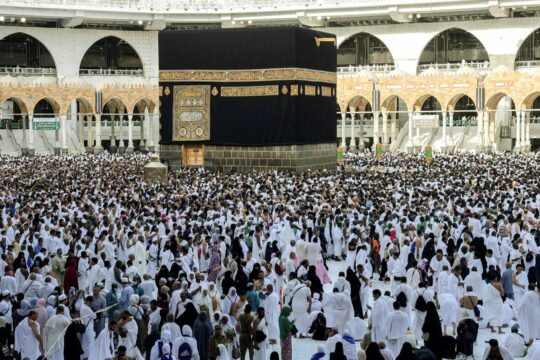
Hajj, also called ḥadjdj or hadj in Islam, the pilgrimage to the holy city of Mecca in Saudi Arabia, which every adult Muslim must do at least once in his life. Hajj is the fifth of the basic methods and institutions of Muslims which is known as the five pillars of Islam. Hajj begins on the 7th of Dhul-Hijjah (the last month of the Islamic year) and ends on the 12th.
Hajj is obligatory on all Muslims who are physically and financially able to perform Hajj, but only if their absence does not cause any trouble to their families. A person can perform Hajj by proxy, appointing a relative or friend to perform Hajj for his “defense”.
The pattern of Hajj rituals was established by the Prophet Muhammad (peace be upon him), but it has undergone variations, and strict formal travelogues are not strictly observed by the large number of pilgrims, who often visit Mecca. Go to different places according to their proper order.
When the pilgrim is about 6 miles (10 km) from Mecca, he enters a state of purity and purity called ihram and wears ihram clothes. For men, they consist of two white smooth sheets wrapped around the body, while women can wear sewn clothes. Pilgrims do not cut their hair or nails until the Hajj is over. They enter Makkah and walk seven times around the Holy Shrine called the Ka’bah, in the Great Mosque, kissing or touching the Black Stone (the Black Stone) in the Ka’bah, twice towards Ibrahim and towards the Ka’bah. Pray , And run seven times between the minor significance of Mount Safa and Mount Marwah. On the seventh day of Dhul-Hijjah, the pilgrims are reminded of their duties. In the second phase of the ritual, which takes place between the 8th and 12th day of the month, the pilgrims go to the holy places outside Mecca – Jabal al-Rahma, Muzdalifah and Mina – and sacrifice an animal in remembrance of Abraham’s sacrifice. . After this, the heads of the male pilgrims are usually shaved, and the female pilgrims remove the hair lock. After the rite of stoning in Mina, in which pilgrims throw seven stones on three walls for three days in a row (former pillar, symbol of the devil), farewell Tawaf of the Ka’bah before the pilgrim leaves the city, or return to Makkah to perform Tawaf.
About 2 million people perform the Hajj each year, and the ritual serves as a unifying force in Islam, bringing together followers from diverse backgrounds in religious celebrations. Once the believer completes the Hajj, he can add the title ḥajjī (for men) or ḥājjah(for women) to his name. Hajj, if performed properly, is believed to erase the past sins of the sincere believer.
